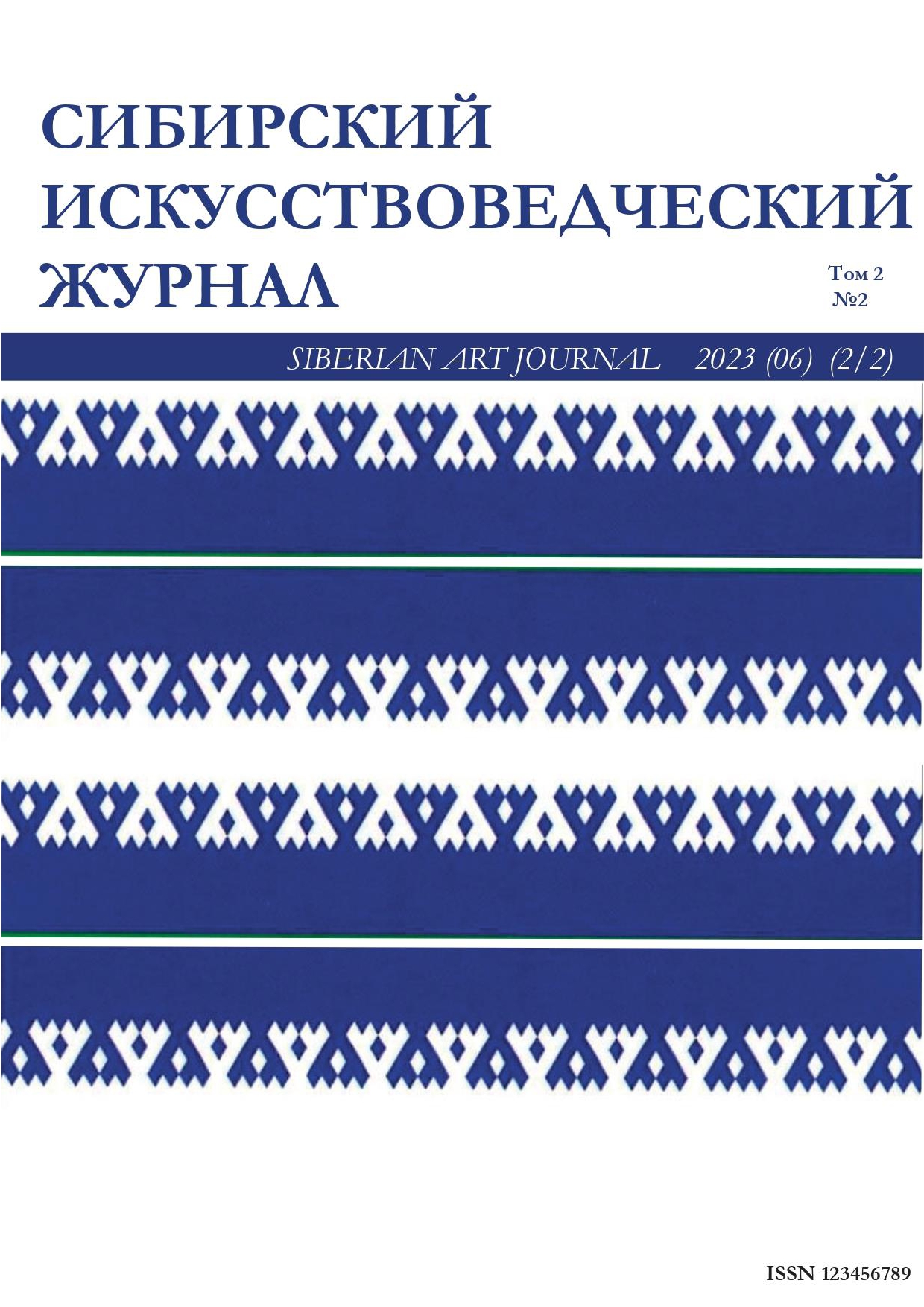Artificial intelligence is an urgent topic for scientific research today. Artificial intelligence is a human assistant in solving certain tasks, helps to automate many processes, including the analysis of audiovisual content. This article provides an overview of the literature on the existing topic. The literature divided into three thematic blocks. The conclusion is that this topic poorly studied in Russian science, and many tools for automated analysis of audiovisual content are under development.
artificial intelligence, machine learning, humanities, cinematography, automated analysis, neural networks
1. Alekseev, A. V., Fomenkov, S. A., (2015). Automated approach to context-dependent analysis of a video stream. News of Volgograd State Technical University, 35-39.
2. Brink, X., Richards, D. (2017). Mashinnoe obuchenie. Piter: SPb, 336.
3. Voznyuk, P. A. (2019). The history of development and the current state of artificial intelligence / P. A. Voznyuk // Globus: technical sciences, 11-19.
4. Grebenyuk, A. A. (2022). Machine learning for image classification. Belgorod State Technological University named after V. G. Shukhov, 103-108.
5. Dyakov, N. V., Saxno, V. V. (2021). Overview of the main types of machine learning. Modern science. 130-133.
6. Enikolopov, S. N., Kuzneczova, Yu. M. (2021). Method of relational situational text analysis in psychological research. Psychology, 18 (4), 748-769.
7. Kizhner, I. A. (2001). Digital technologies of cultural inheritance in modern society. Krasnoyarsk. 182 p.
8. Kistova, A.V. (2020). Synthetic model of culture and cultural practices. Siberian Anthropological Journal, 4 (2), 111-121. doi:https://doi.org/10.31804/2542-1816-2020-4-2-109-119. EDN KLMBSN.
9. Kolesnik, M. A. Sitnikova, A. A., Andryushina, Ya. D. (2023). Artificial intelligence as a tool and co-author in the work of contemporary artists: examples of artistic practices and analysis of works of visual art. Sociology of Artificial Intelligence, 4 (1), 37-51. doihttps://doi.org/10.31804/2712-939X-2023-4-1-37-51. EDN UOQRVI.
10. Mak-Kallok, U.S., Pitts, V. (1956). Logical calculus of ideas related to nervous activity. U.S. McCulloch. In the collection: «Automata» edited by K.E. Shannon and J. McCarthy. Moscow: Publishing House of Foreign Lit, 363-384.
11. Omelik, A. A. (2023). Factors of artificial intelligence influence on the creative process. Sociology of artificial intelligence, 4 (1), 52-63. doihttps://doi.org/10.31804/2712-939X-2023-4-1-52-63. EDN YTVWUK.
12. Ostroux, A. V. (2020). Introduction to artificial intelligence: monograph. Krasnoyarsk: Scientific and Innovation Center, 250.
13. Petrova, M. G. (2020). Artificial intelligence in the methodology of teaching foreign languages. Modern science: actual problems of theory and practice. Series: Humanities, 5(2), 62-66.
14. Pospelov, D. A., Osipov, G. S. (1999). Applied semiotics. Artificial Intelligence News, 9-35.
15. Sirazetdinova, M. F. (2014). Socio-humanitarian knowledge and artificial intelligence. Information technologies of intellectual decision support, 207-209.
16. Sitnikova, A. A. (2021). Theoretical, applied and synthetic methods of studying culture as a socio-anthropological system. Social anthropology of Siberia, 2 (2), 6-17. EDN ICEFEC.
17. Slyusarev, V. G. (2020). Problems of artificial intelligence in the humanities. Technology, science, management: personnel for the digital economy: proceedings of the conference, 173-177.
18. Yacenko, O. Yu. (2017). Problems of artificial intelligence in the humanities. Step into the future: Artificial Intelligence and Digital Economy: Proceedings of the First International Scientific and Practical Conference, 321-327.
19. Agnihotri, L. Dimitrova, N. (2015). Text Detection for Video Analysis. Third IAPR Asian Conference on Pattern Recognition, 1-5.
20. Boon-Lock, Y., Yeung, M. (2001). Extracting Story Units from Long Programs for Video Browsing and Navigation. Readings in multimedia computing and networking, 296 - 305.
21. Burghardt, M., Heftberger, A. et al. (2020). Film and Video Analysis in the Digital Humanities - An Interdisciplinary Dialog. Digital humanities quarterly, 1-18.
22. Cetinic, E., She, J. (2022). Understanding and Creating Art with AI: Review and Outlook. ACM Transactions on Multimedia Computing, Communications, and Applications, 2, 1-22.
23. Ewerth, R., Mühling, M. et al. (2009). Videana: A Software Toolkit for Scientific Film. Media/rep, 101-116.
24. Hatalova, D. (2020). Cinema in the Age of AI. SFU Undergraduate Research Symposium, 43-51.
25. Hebb, D. (1949). The Organization of Behavior: A Neuropsychological Theory. Psychology, 633-642.
26. Image Plot visualization software: explore patterns in large image collections. [Electronic source]: http://lab.softwarestudies.com/p/imageplot.html
27. Lewis, J. W., Valente, A. (2008). Tactical Language and Culture Training Systems: Using AI to Teach Foreign Languages and Cultures. Proceedings of the Twenty-Third AAAI Conference on Artificial Intelligence, AAAI 2008, Chicago, Illinois, USA, July 13-17, 72-83.
28. McCarthy, J. (1960). Recursive Functions of Symbolic Expressions and Their Computation by Machine, Part I. Massachusetts Institute of Technology, 1-34.
29. Nowak, A., Lukowicz, P. et al. (2018). Assessing Artificial Intelligence for Humanity. Will AI be Our Biggest Ever Advance - or the Biggest Threat? Technology and Society, 4, 26-34.
30. Pustu-Iren, K. (2020). Automated Visual Content Analysis for Film Studies: Status and Challenges. Computer Science, 1-19.
31. Saur, D. D., Tan, Y.-P. et al. (1997). Automated analysis and annotation of basketball video. Digital Library, 77-83.
32. Suchan, J., Bhatt, M. (2016). Semantic question answering with video and eye-tracking data: AI foundations for human visual perception driven cognitive film studies. Proceedings of the Twenty-Fifth International Joint Conference on Artificial Intelligence, 2633-2639.
33. Tadeo Fuica, B., Buisson, O. et al. (2021). Watching Historical Films Through AI: Reflections on Image Retrieval from Heritage Collections. Cinergie - Il Cinema E Le Altre Arti, 97-112.
34. Turing, A. M. (1950). Computing Machinery and Intelligence. Mind 49, 433-460.
35. Wyrobek, J. (2020). Application of machine learning models and artificial intelligence to analyze annual financial statements to identify companies with unfair corporate culture. Procedia Computer Science 176, 3037-3046.
36. Zhou, Y., Zhang, L. et al. (2019). Predicting movie box-office revenues using deep neural networks. Neural Computing and Applications, 35-41.





